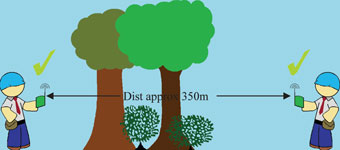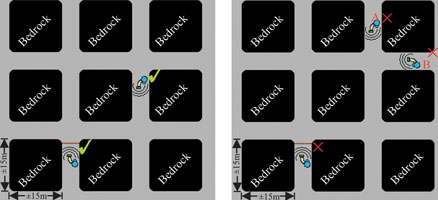
SIMCom’s SIM20A is a short-range transceiver operating in the 433–434,79 MHz frequency band.
On paper, the device is capable of transmission over distances up to 1500 metres. However, as anybody who has ever implemented long-range wireless systems would know, these sorts of specs are achieved under very carefully controlled conditions, using costly high-gain directional antennas, in perfect line-of-sight conditions.
In response to requests from customers wanting to know real-world expected specs under South African conditions, Otto Wireless Solutions, a local distributor of SIMCom products, ran a variety of tests under conditions which are as close to typical industry deployments as possible. In putting the paper specs to the test, a low-cost and readily available quarter wavelength stubby antenna was used, and the devices were taken into two typical South African environments.
In selecting the test environments and test equipment setup, Otto considered the target market where the devices are most likely to be deployed. The SIM20A is basically a mesh network RF device; an RF module which is able to function as a transceiver or a transceiver plus repeater. The repeater capability lends itself to a wide variety of applications, where the designer is no longer reliant on pure line-of-sight transmission; although line-of-sight is the limiting and important factor, the repeater functionality allows one to extend the range beyond pure line-of-sight between the data source and the end point.
The first environment selected was out in the open, in the Meyerton area. This environment was chosen in order to simulate a rural/farming type of deployment. The device was tested along a straight sand road, then over a small hill and finally through dense foliage.
The second environment was an underground coal mine in Secunda, where the device was tested underground, within the confines of bedrock tunnels. The testing was carried out on straight paths, around corners, with a coal train vehicle between the source and end points, and also within close proximity to heavy underground mining machinery.
Environment 1 – Rural area testing
Farming applications are notoriously difficult to manage via RF networking. Ideally, one needs a low power consumption device capable of reasonably long transmission distances. Antennas should not draw unwanted attention to the location of units, mainly due to concerns over vandalism and security. In selecting a test area, Otto chose a location which presented simple diversity; one that offered flat areas with clear line-of-sight, hills and dense foliage. The Meyerton area presented all three, and the testing was carried out under clear skies.
Test 1: Uninterrupted line-of-sight in open air
The first test was kept as simple as possible. The testing was carried out on a flat gravel road, using the quarter wavelength stubby antenna, and line-of-sight was maintained. With the device baud rate set to 115 200, reliable communications were achieved at an effective over-the-air data rate of 2400 bps, over a distance of up to 340 metres. In this scenario, for peace of mind, a safe and conservative distance of 350 metres is recommended.

Test 2: Small hill interrupting line-of-sight in open air
In the second test, using the same set of equipment, reliable transmission distance was tested when line-of-sight was interrupted by a small hill, with one test unit just over the line-of-sight of the crest of the hill. With the device baud rate set to 115 200, reliable communications were achieved at an effective over-the-air data rate of 2400 bps, over a distance of up to 120 metres.

Test 3: Dense foliage interrupting clear line-of-sight
In the third, the same set of equipment was again used, this time testing for reliable transmission distance when line-of-sight was interrupted by dense foliage, such as trees, bushes and other natural obstructions. With the device baud rate set to 115 200, reliable communications were achieved at an effective over-the-air data rate of 2400 bps, over a distance of up to 350 metres.

In this scenario, for peace of mind, 300 metres is recommended as a safe and conservative distance.
Environment 2 – Industrial/mining testing
Test 1: Uninterrupted line-of-sight in a mining tunnel
Again, the first test was kept as simple as possible. The testing was carried out in an uninterrupted stretch of underground tunnel. The height of the tunnel, from floor to ceiling, was approximately 2 metres, and the walls themselves were bedrock, lined with coal. With the device baud rate set to 115 200, reliable communications were achieved at an effective over-the-air data rate of 2400 bps, over a distance of up to 300 metres. A safe and conservative range under these conditions is recommended at 280 metres.

Test 2: Coal train interrupting line-of-sight
In the second test, using the same set of equipment, reliable transmission distance was tested when line-of-sight was interrupted by a moving coal train.
The coal train took up a significant portion of the tunnel and as a result, when the train moved between the transmitter and receiver, communication capability was negligible, regardless of the distance between the source and destination.

Test 3: Bedrock support pillars interrupting line-of-sight
In the third variation, testing moved into an area of the mine containing a number of bedrock support pillars of approximately 15 x 15 metres, forming a grid pattern of passages of roughly 4 metres in width. The height from floor to ceiling was still approximately 2 metres. In addition to the pillars, there were also a number of industrial dust curtains, which ran the full width and height of the passages. Testing was conducted with one person remaining stationary behind one such dust curtain.

It was found that the signal attenuated very rapidly. Although the RF communications were reliable through one dust curtain, and around two corners of bedrock, this communication was reliable only up to approximately 30 metres; thereafter the transmission was quickly lost, regardless of whether the testers moved around any further corners or not, pictured as positions A and B in Figure 6.
Test 4: Heavy operational mining machinery interrupting line-of-sight
In the final and most gruelling test, the devices were tested while in the vicinity of running mining machinery, whilst remaining underground. This sort of machinery is notorious within the RF arena for being a source of tremendous spurious noise, ultimately leading to severe attenuation of signal strength. In this environment, transmission was successful over a distance of approximately 12 metres.

Conclusions and recommendation
Overall, the SIM20A performed well, and is suitable for a wide variety of applications.
In rural, farming applications, the device performs very well, and with low-cost hardware, one can make use of the repeater functionality and inexpensive quarter wavelength stubby antennas to set up a reasonably sized RF mesh network. The data rate over the air is reasonable for most industrial and low-cost applications, and the cost of deployment is not prohibitive, provided one exercises a bit of common sense when setting up the network. By and large, the setup should be fairly simple.

In mining applications, there are many more challenges to be considered. Although testing along a straight tunnel was successful up to 300 metres, one needs to keep in mind that the tunnels are narrow, and as soon as a coal train (which took up about 80% of the tunnel) moved between the two test points, it was not possible to get any sort of RF data transmission between the test points, until the train had moved out of the way. This immediately means that it is necessary for the designer to implement a suitable level of error checking into the system, so that if acknowledges are not received, the data can be re-transmitted.

When the devices were tested within the area of the bedrock support pillars, repeaters at key corners would have extended the range significantly, and so although the testing was successful through only one dust curtain and around two corners, this solution can certainly be considered successful and usable. In the area of the heavy machinery, 10 metres was also acceptable, as this is an area where many RF devices fail.
Although testing was limited to one mine, and one therefore has to consider factors such as bedrock material, width of mining shafts and variation of materials used in mines (such as the dust curtains), overall the SIM20A performed well under extremely tough conditions, and it can therefore be concluded that this low-cost device can provide suitable and reliable RF connectivity in many low data rate industrial applications.
For more information contact Chris Viveiros, Otto Wireless Solutions, +27 (0)11 791 1033, [email protected], www.otto.co.za

© Technews Publishing (Pty) Ltd | All Rights Reserved